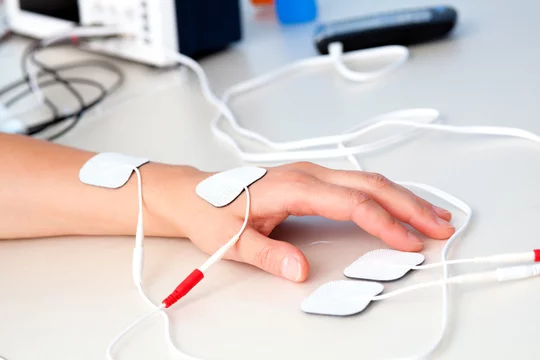The cold & flu season is in full effect! - Strengthen your immunity with IV Vitamin Therapy now!
Electric stimulation therapy is utilized for various purposes within the field of rehabilitation. Its primary objective is to harness the power of electrical currents to strengthen muscles, alleviate pain signals, and enhance blood flow.
When an individual is afflicted by an injury or illness that induces discomfort or restricts their mobility, their rehabilitation program may incorporate electric stimulation, commonly referred to as e-stim.

This therapeutic technique involves applying electrical stimulation to address muscle spasms and alleviate pain. It plays a crucial role in preventing muscle atrophy and promoting strength among patients with injuries. Additionally, it proves beneficial in sustaining muscle activity, particularly following incidents such as spinal cord injuries or strokes.
During electric stimulation therapy, physical therapists and other healthcare professionals affix electrodes onto the patient's skin, thereby prompting the targeted muscles to contract. By employing electric stimulation, patients can sustain muscle tone and strength that would otherwise diminish due to lack of utilization.
The mechanism behind electric stimulation therapy mimics the natural process through which the body exercises its muscles. The electrodes, when attached to the skin, emit impulses that induce muscle contractions. This approach proves advantageous in enhancing the patient's range of motion and improving overall circulation. Moreover, it serves as an effective treatment for conditions such as sprains, arthritis, back pain, scoliosis, and sciatica.
The journey towards recovery can often be a demanding and protracted one. Individuals yearn to regain their well-being and resume their daily routines and cherished pastimes. In this endeavor, chiropractors play a vital role by accompanying patients along the path to recovery. To expedite patients' rehabilitation goals, chiropractors employ various therapeutic techniques, among which electrical muscle stimulation (EMS) holds significant prominence.
Now, let's delve into the realm of EMS, exploring its benefits as a treatment modality, understanding its mechanism of action, and discovering the range of conditions it can effectively address.
EMS, as a focused rehabilitation treatment, synergistically complements manual therapy and other rehabilitative activities and therapies. Its primary objective is to bolster the recovery process by selectively activating particular muscles, thereby preventing muscle wasting and fostering strength development. This method of electrical muscle stimulation proves invaluable in mitigating pain and restoring muscular strength subsequent to injuries, surgical procedures, or spasms.
EMS, when employed for the purpose of enhancing or restoring muscle strength, operates by transmitting gentle electrical pulses to the specific muscle group being targeted. Chiropractors affix electrodes onto the patient's skin to induce muscle contractions. These electrical impulses mimic the signals generated by the brain and emulate the body's natural response mechanism.
In the context of pain management, targeted nerves receive electrical stimulation. Chiropractors utilize electrodes to direct the electrical pulses to specific regions of the nervous system, thereby obstructing the transmission of pain signals towards the spine and brain. Additionally, this stimulation fosters an increased production of endorphins within the body, which serve as natural pain relievers.
The benefits of EMS can help many patients with varieties of conditions.
EMS has demonstrated its effectiveness in enhancing both mobility and strength for patients undergoing recovery from severe injuries. It serves as a valuable component within rehabilitation and occupational therapy programs. The stimulation provided by EMS aids in retraining muscles to appropriately respond to the body's natural signals, leading to increased strength through repeated contractions. This proves particularly advantageous when patients are engaged in the process of reacquiring fundamental motor functions.
Individuals who have experienced spinal cord injuries or paralysis can effectively sustain muscle activity through the utilization of electrical stimulation. Moreover, therapists employ electrical stimulation to assist critically ill patients in exercising and preserving muscle tone that would otherwise deteriorate due to lack of use. This approach proves valuable in maintaining muscle functionality and preventing muscle atrophy in these patient populations.
Patients enduring chronic pain can derive notable benefits from electrical stimulation as well. This form of therapy utilizes a distinct wavelength that specifically targets the nerves within the body. By impeding the activity of pain receptors responsible for transmitting signals of discomfort to the brain, this drug-free therapy proves effective in delivering relief to individuals suffering from chronic pain.
Russian Stimulation - This electrical stimulation works to improve muscle contraction and address weakness.
IFC - Interferential current (IFC) electrical stimulation is designed to alleviate pain and encourage circulation to affected tissues in the body.
High Voltage Stimulation - Chiropractors perform EMS with high voltage to enhance wound healing.
Iontophoresis - A form of electrical stimulation that can aid medication penetration through the skin. It is used to ease inflammation, reduce swelling in the affected area, lessen scar tissue formation, and relax spasming muscles.
In the field of chiropractic and rehabilitation, electrical muscle stimulation can be used to treat the following conditions.
Typically, therapy sessions last between 9 to 15 minutes. Throughout this duration, you may experience a gentle tingling sensation and repetitive muscle contractions, which are part of the therapy.
It's important to note that EMS should never cause any pain. During your appointment, a chiropractic assistant will carefully place small electrodes on your skin. These adhesive electrode pads will be strategically positioned around the targeted area for stimulation. Wires will connect the pads to the EMS device, which will deliver the necessary electrical current for the therapy.
Throughout the session, the chiropractor will have full control over the intensity of the electrical current. Typically, this entails commencing with a low level of stimulation and progressively raising the setting. As a result, the targeted muscles will gradually contract with greater force. Your chiropractor may also request you to perform specific motions while the pulses are being administered. This interactive approach allows for tailored treatment and ensures optimal engagement during the therapy session.
When EMS is used to relieve pain or muscle spasms, the patient is encouraged to relax during the therapy session.
Interferential current therapy (ICT), also known as IFC, is a widely utilized method of electrical muscle stimulation for managing chronic pain resulting from surgery, injury, or trauma. When incorporated into physical therapy or rehabilitation programs, the ultimate objective of ICT is to alleviate pain and facilitate accelerated healing. This non-invasive and medication-free therapy is associated with minimal side effects.
Distinguished by its higher frequency energy compared to other forms of EMS, ICT surpasses the superficial layers of the skin. It effectively penetrates deep into the body, precisely targeting the root cause of pain without causing any discomfort. This allows for effective pain relief and targeted treatment with remarkable precision.
Interferential current therapy (ICT) operates by delivering precise and mild electrical stimulation to the damaged tissues within the body. The primary objective of this therapy is to enhance the body's innate pain response mechanism, while concurrently promoting increased blood flow and the production of healing-promoting hormones.
ICT employs two different frequencies for stimulation: one at approximately 4000Hz and the other variable up to 400Hz. When these two currents intersect, the variance in frequency creates interference, which gives the therapy its name. The specific frequencies, as well as the resulting interferential frequency, can be regulated by physical therapists during the session.
By utilizing the principle of interference, the interferential current effectively permeates deep into the targeted muscle tissue or nerves, facilitating precise and targeted treatment. This synergistic effect is what renders ICT a potent therapeutic modality, while minimizing the discomfort typically associated with low-frequency stimulation.
ICT is frequently employed to address a range of conditions including muscle strains, spasms, sports injuries, joint damage, and edema. It proves beneficial in relieving chronic pain associated with arthritis, surgery, muscle damage, injuries, as well as mitigating symptoms like inflammation and swelling. As part of a comprehensive treatment plan, IFC is often utilized in conjunction with chiropractic care and physiotherapy.
The treatment focuses on specific areas of the body, aiming to alleviate soreness, facilitate healing, and expedite recovery. Through ICT, stimulation can be effectively delivered deep into localized areas of the tissue, targeting and addressing the following concerns:
There are some cases wherein interferential current therapy is incorporated as part of a patient’s pain management program.
The application of this stimulation triggers the release of endorphins, which play a pivotal role in promoting recovery. Simultaneously, it enhances blood circulation to the targeted area, providing support to the body's inherent healing mechanisms. ICT is effective in reducing swelling, alleviating inflammation, and minimizing or eliminating pain. Furthermore, it has the potential to enhance joint mobility and expand the range of motion. Through these mechanisms, ICT contributes significantly to the overall healing and rehabilitation process.
Despite initial perceptions, ICT is a safe and painless treatment modality. In fact, many patients report experiencing less discomfort and fewer side effects compared to other forms of electrical stimulation. The sensation most commonly described during ICT is a gentle tingling or "pins and needles" feeling on the skin.
Typically, interferential current therapy entails sessions lasting approximately 9 to 15 minutes. Throughout this time, the physiotherapist will affix four electrode pads to the designated treatment area. These pads are then connected by wires to a device that regulates the intensity of the current, delivering the specific frequencies necessary for the therapy. Rest assured that the procedure is straightforward and well-tolerated by most patients.
If you believe you could benefit from high-quality care, consider getting treatment from the staff at Wellness First Medical & Chiropractic Center. Our dedicated staff will be pleased to answer your questions today. We can also help you schedule a time to visit our Dickinson, TX office.
Call Us: (281) 337-3337 to make/change your appointment Or email us at: frontdesk@wellnessfirstmedicalcenter.com
Meet our Chiropractor
Dr. Donna Sanders, DC
Clinic Director
For over 32 years, Dr. Donna Sanders, DC has been dedicated to serving people in the surrounding communities of Galveston County with the most up to date, holistic, chiropractic care.

Meet our Chiropractor
Dr. Ross Baird, DC
Dr. Ross Baird, DC is a 2017 graduate of Texas Chiropractic College. He is also an alumni of Texas A&M, having majored in Biology. Through his own life experiences and health challenges, Dr. Baird is passionate about helping his patients not only with acute injuries, but also at deeper levels of health and wellness.

Please fill out the form below to learn more about our services. *are required fields.
Monday: 8am-12pm | 2pm-6pm
Tuesday: 8am-12pm | 2pm-6pm
Wednesday: Closed
Thursday: 8am-12pm | 2pm-6pm
Friday: 8am-12pm | 2pm-6pm
Saturday: Closed
Sunday: Closed